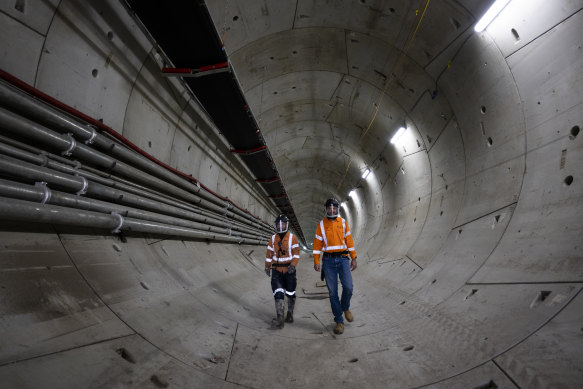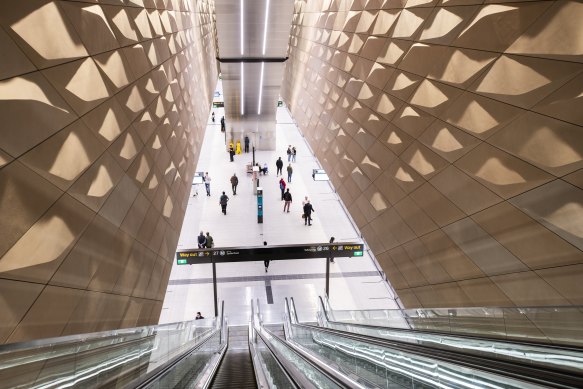This was published 10 months ago
The eastern line hidden in $34 billion plan for next generation of Sydney’s metro
It is the question many Sydneysiders want to know: where will the next generation of the city’s metro rail projects go?
Secret until now, a final report from a wide-ranging review commissioned by the Minns government last year helps provide an answer.
It lifts the lid on thinking about future metro projects at the most senior levels of the state’s transport and planning bureaucracy after the $25 billion Metro West line between Parramatta and central Sydney is completed in 2032.
Marked “Sensitive – NSW Cabinet”, the review charts a path for building up to six major rail projects over the next two decades in one of the OECD’s fastest-growing cities. An extra million residents forecast for Sydney by 2041 means the city will need at least 30,000 new homes a year, which will have to be supported by transport infrastructure.
The review, led by former federal infrastructure secretary Mike Mrdak, thrashed out various options for future rail projects after the latest metro lines committed to by the government were complete.
The review canvassed an extension of the Metro West line from the under-construction Hunter Street station in the CBD to Zetland by 2042 at a cost of up to $9.3 billion.
The eight-kilometre extension to Zetland would comprise up to three stations, including an extra one in the CBD under Elizabeth Street near Hyde Park or Haymarket, to reduce pressure on the Hunter Street station.
An extension to Zetland was part of the business case for Metro West but was dropped by the previous Coalition government in 2018 due largely to the cost.
Transport for NSW’s longer-term strategy has previously identified an extension of Metro West eastwards from the CBD towards Randwick and La Perouse as the next stage of creating a transport spine for the city.
In concert with a separate review into the state’s infrastructure, Mrdak’s team settled on an “ideal assumption” of up to $4 billion a year in capital spending, adding that rail corridors in the city’s west offered the strongest housing, transport and economic development options.
It drew on two scenarios for spending on new lines by the late 2040s from Sydney Metro, the government agency overseeing the mega projects.

Tunnels for the new metro rail line to Western Sydney Airport.Credit: Janie Barrett
Under one scenario, it proposed extending the Western Sydney Airport metro line further south from the new city of Bradfield to “Bradfield South” by 2032 at a cost of $2.3 billion, as well as an extension of the heavy rail line from Leppington to Bradfield South by 2033 for $4.6 billion.
If the plans are realised, they would be followed by a northern extension of the airport metro line from St Marys to Schofields by 2037 costing $9.6 billion and onto Tallawong by 2039 for a further $3.2 billion.
It put on the table an extension of the airport line from Bradfield South to Oran Park by 2047 at a cost of $5.1 billion.
Three years ago, the $11 billion metro line under construction between St Marys and Bradfield via Western Sydney Airport came in for heavy criticism from the country’s peak infrastructure adviser, which warned the cost would far outweigh the benefits.
The final Mrdak report warns that the 23-kilometre line, which is due to be completed in late 2026, will be a “largely ‘stranded’ public transport service” only connecting passengers from St Marys to the new airport until extensions north and south are completed.
“The implications are that this investment will not service western Sydney’s long-term needs without additional metro and heavy rail connections,” it states. “[It has] not, in our view, been planned with a sufficiently holistic focus on the housing and economic development opportunities.”
It is why the review team rated as a “priority action” a short extension of the line from Bradfield to a new “Bradfield South location” before building an extension north to Schofields.
All up, the review puts the total cost of the projects at almost $56 billion over the next two decades, representing a cost of $34 billion in 2023 dollars, taking inflation into account.
Before then, the release of a sensitive document detailing potential routes for future metro projects creates a headache for senior bureaucrats.
The review notes that almost all extension options include sections of “unprotected transport corridors”. The release of likely routes for rail lines risks inflating land values along the potential corridors, making the projects even more expensive for taxpayers to build in the coming decades.
A key recommendation kept secret when the heavily redacted final report from the Mrdak review was released in December was for the government to “prepare an actionable road map … for investing in a 25-year/up to $3b-$4b per annum metro expansion pipeline”.
It listed extensions in “relative priority order”, starting with the “short and rapid metro extension” from Bradfield to a new Bradfield South station. This would be linked from Leppington by a new heavy rail line.
The recommendation was listed in December by the Minns government as “under consideration”.
A spokesperson for Transport Minister Jo Haylen says the government is laser-focused on delivering an existing pipeline of more than $60 billion in metro projects.
“We will make evidence-based investment decisions that are mode-agnostic – not led by ideology. This will allow us to get maximum value out of future projects, including by delivering much-needed housing close to public transport hubs,” he says.

The underground platforms at Central Station for the M1 metro line.Credit: Steven Siewert
So far, the government has committed only to conducting two business cases for future metro extensions from the new airport line.
Coalition transport spokeswoman Natalie Ward says the future pathway of metro in western Sydney is clear. “The next challenge is the vision, delivery and budget management by a government to turn a pathway into a reality,” she says.
The crippling of double-decker train services on several major lines on Monday due to a broken rail at Central Station underscored the value of the recently opened city-section of the M1 metro line, which gave commuters an alternate way to cross the harbour during the morning peak.
Former Transport for NSW secretary Rodd Staples, regarded as the architect of Sydney’s metro system, says the new line under the central city is essential to strengthening the backbone of the transport network’s capacity.
“Where I think the investment needs to shift for metro now is cross-regional links from south-eastern Sydney to Parramatta, north-western Sydney to Western Sydney Airport and those sorts of investments,” he says.
“Paris has continued to invest in its public transport network. My hope is that Sydney will continue to do that as well, and not sort of close up shop with the completion of these current projects.”
Start the day with a summary of the day’s most important and interesting stories, analysis and insights. Sign up for our Morning Edition newsletter.